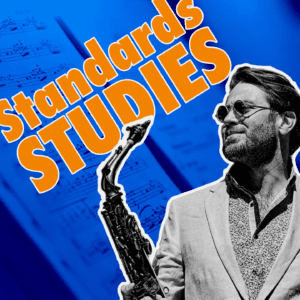“Just You, Just Me” is a song from the 1929 musical film Marianne, composed by Jesse Greer with lyrics by Raymond Klages.
Thelonious Monk‘s 1948 composition, “Evidence”, is a contrafact of “Just You, Just Me”. Monk’s tune was originally called “Justice” (which sounds like “Just Us”, a reference to “Just You, Just Me”), then renamed “We Named It Justice”, and finally “Evidence”.
In this lesson we go through the process of learning the tune with the do solfege, playing the melody rubato and in time, adding the bass notes, improvising rubato and in time, in different keys and I share with you an arrangement I wrote.
We also study the solo transcription of saxophonist Joshua Redman and you get the PDF in concert, Bb and Eb.
Video lessons:
Lyrics:
Just you, just me
Let’s find a cozy spot
To cuddle and woo
Just us, just we
I’ve missed an awful lot
My trouble is you
Oh, gee
What are your charms for?
What are my arms for?
Use your imagination
Just you, just me
I’ll tie a lover’s knot
Around wonderful you
Join us to watch this lesson and download the PDFs!
– techniques of motif development used in this solo (extension, transformation, displacement, transposition, fragmentation)
– melodic motif, rhythmic motif
– his re-harmonization over a II V I progression
– phrases to transpose in 12 keys
– targeted notes and group of approach notes
– the melodic force is stronger than any theoretical rule
– how he reuses some ideas to create continuity
– how he uses different improvisation techniques to create contrast
– how he subdivides 2 bars of 4/4 into 2 bars of 3/4 plus 1 bar of 2/4
– use of the minor pentatonic to give a blues flavor
– the general architecture of the solo




10 comments on “Just you, just me”
After reharmonizing “Just You, Just Me” I wrote a new melody 🙂 Here my composition “Us Alone”
Yeah! here is Angele practicing the solo!
Pingback: Latest Lessons | Jazz Video Lessons With Alex Terrier
Now listening to Joshua Redman, pay attention to his phrasing, his rhythmic activity (very rich, a lot of rhythmic displacement, syncopations, repeated notes), use of the upper register. He has a pretty brilliant sound, most probably he is playing a metal mouthpiece on this recording.
It’s interesting to notice that he takes a second solo, that’s unusual, but it sounds good! notice how motivic his playing is on that second solo.
When listening to this track there is no question how huge of an influence Sonny Rollins is on Joshua Redman.
One thing I don’t like very much is the mix. the sax is so much in front of everybody else. I prefer when the soloist is not so much in front in the mix and blends better.
Check out how the pianist starts his solo with the last phrase of the sax solo.
Joshua Redman is very strong and creative rhythmically, often Hutchinson on drums takes some of Redman’s idea to answer him, can you hear that?
Notice the way the pianist is comping the sax solo: he alternates syncopated playing and on the beat.
Also I feel like on the A sections he kind of plays off the rhythms of “Evidence”, the tune by Monk that is based on “Just you, just me”, fairly syncopated and then he plays long notes on the bridge to create contrast.
The piano plays in a very supportive way, very classic, doesn’t feed much, really put himself in the position of comping as clearly as possible.
In his solo, although we are not gonna transcribe it, you should be able to recognize the group of approach notes we have talked about in previous lessons. Also he uses some motives and transpose them.
When listening to the bass you should start hearing the changes, at least the basic harmonic progressions such as II V I. Also going to the IV on the bridge is very classic and one should hear that very easily just with the bass line.
Notice how Ray Brown plays ONLY quarter notes on the down beat, he never plays any syncopation, he is really the foundation of the pyramid and a strong driving force.
Gregory Hutchinson is also a driving force but on another level. Of course his playing is much more active and syncopated. Notice hoe he clearly indicates the form. I can start the recording at any moment and recognize where we are in the form by listening to the drummer. His way of announcing the bridge is different from the way his playing at the top of the form. Also notice how he plays more sparsely at the beginning of the piano solo to let the music breathe.
Pingback: Free Lessons! | Jazz Video Lessons With Alex Terrier